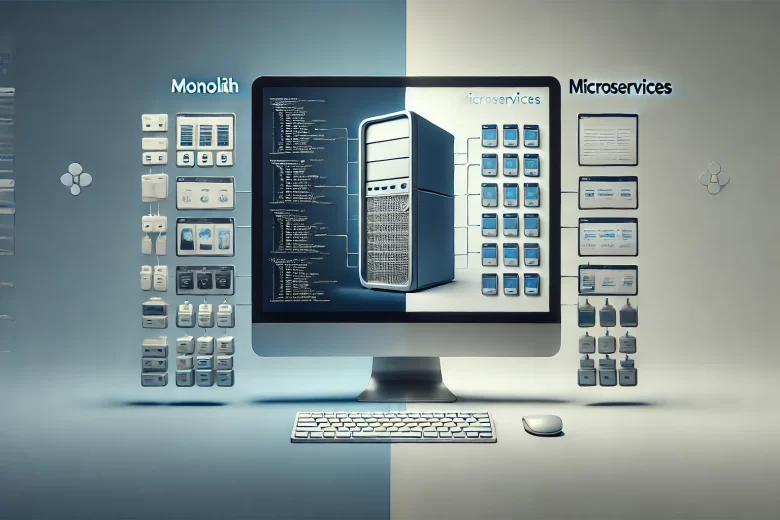TL;DR
Monoliths are large, all-in-one applications where everything is connected, while microservices are made up of smaller, independent parts that work together. Monoliths are easier to start with but harder to scale, while microservices are more flexible and scalable. This guide will help you understand the pros and cons of each approach and decide which is best for your project.
Introduction
When building software, one of the biggest choices is deciding between a monolithic or microservices architecture. Understanding these two approaches can help you choose what’s best for your project. Each has its strengths and weaknesses, and the right choice depends on your needs, team size, and future growth plans.
What Is a Monolithic Architecture?
A monolithic application is a single, unified system where everything is connected. All the features—like the user interface, database, and business logic—are built together. Imagine it as one giant building where all rooms are part of the same structure.
Monoliths are great for smaller projects or when you’re just getting started because everything is in one place and easy to manage.
Pros of Monolithic Architecture
- Simple to Develop and Test: Since everything is in one codebase, it’s easier to build and test the whole system.
- Easy to Deploy: You only need to deploy one unit, making the deployment process simple.
- Simple Communication: All parts of the application are in one place, making it easier for them to communicate.
Cons of Monolithic Architecture
- Scaling Issues: You can only scale the entire application, even if only one part needs more resources, which can be inefficient.
- Hard to Update: Changing one part of the system can affect the entire application, making updates more difficult.
- Slow for Large Projects: As the application grows, adding new features can become slower and more complex.
What Are Microservices?
Microservices architecture splits the application into smaller, independent services that each handle a specific function. For example, one service might handle user login, another might manage orders, and another might handle payments. Think of it as a city with different buildings, each with its own purpose.
Microservices are used in larger projects that need to scale and allow for faster development cycles. Each service is independent, so teams can develop, update, and scale them separately.
Pros of Microservices Architecture
- Scalable: You can scale each service independently, which saves resources.
- Flexible Technology: Different microservices can use different technologies based on what works best for them.
- Independent Deployment: You can update one service without affecting the rest of the application.
- Resilient: If one microservice fails, the rest of the system can keep working.
Cons of Microservices Architecture
- More Complex: Managing multiple services can be challenging.
- Deployment Overhead: Deploying many services separately can be more complicated.
- Data Consistency: Keeping data consistent across all services is harder because the data is spread out.
Key Differences Between Monoliths and Microservices
- Architecture: Monoliths are one big system, while microservices are made of separate, independent parts.
- Scalability: Monoliths are harder to scale, while microservices let you scale the parts that need it.
- Development Speed: Monoliths are easier to start with, but microservices are better for parallel development.
- Deployment: Monoliths are deployed as one unit, while microservices can be deployed independently.
Latency and Complexity Considerations
- Latency: Monoliths have no network latency since everything is local. Microservices use a network to communicate, which can slow things down, but techniques like parallel calls can help.
- Complexity: Monoliths are simpler to develop and manage, while microservices need more effort to coordinate, especially with tools for logging and tracing across services.
Migration from Monolith to Microservices
Migrating from a monolith to microservices takes careful planning. Here are the steps for a successful migration:
- Define Your Goals: Know what you want to achieve, like better scalability or faster updates.
- Identify Dependencies: Understand how different parts of the monolith are connected.
- Start Small: Begin by migrating features that are easy to separate, like notifications.
- Use APIs: Set up APIs for communication between the old system and new microservices.
- Migrate Data Gradually: Move data in phases to keep everything stable.
- Set Up CI/CD: Use continuous integration and delivery for smooth updates.
- Test Thoroughly: Make sure everything works before fully switching over.
Real-World Examples of Migration
- Netflix: Moved from a monolith to microservices to handle their growing user base, allowing them to scale more effectively.
- Amazon: Shifted from a monolithic structure to microservices to scale faster and support independent service development.
- Uber: Adopted microservices to support its rapid expansion and improve resilience.
When to Choose Monolith vs. Microservices
- Monolith: Choose a monolithic architecture for small projects, quick development, or when you have a small team. It’s best when simplicity is key.
- Microservices: Choose microservices for large projects, high scalability, or when you need frequent updates. They’re great when different parts of the application need to scale separately.
Conclusion
Choosing between a monolithic and microservices architecture depends on your needs. Monolithic architectures work well for small projects that need simplicity and quick development, while microservices are better for complex applications that need to scale and adapt. Consider your project’s size, your team’s abilities, and your future growth to make the right choice.
If you’re building a new project, start simple with a monolith, and switch to microservices as your needs grow. Weigh the pros and cons to see which option fits your situation best.
}
]
}


